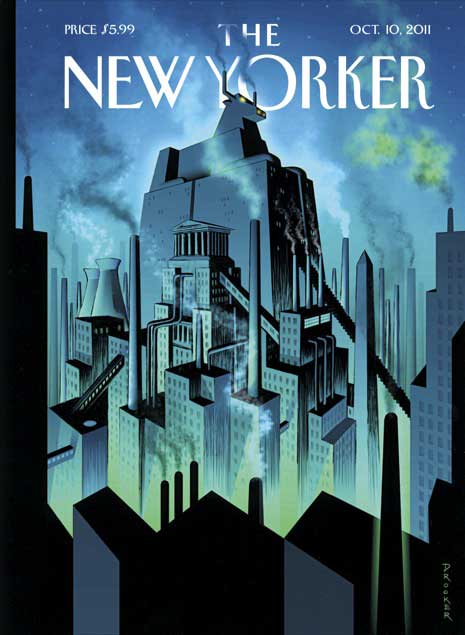
Editorials
Planning More of Those Robot Apartments for Berkeley
By Becky O'Malley
Wednesday October 12, 2011
Much to my surprise, last week’s New Yorker cover seemed to be devoted to Berkeley’s in-the-works new Downtown Area Plan.
Thanks to sometime Planet contributor Tom Lord, we’ve learned that cover artist Eric Drooker, who lives in downtown Berkeley, seems to have been riffing on an animation he did to go with a film version of Alan Ginzberg’s Howl—the sinister figure at the top of the skyscrapers is Ginzberg’s Moloch:
"Moloch whose Soul is electricity and banks!"
"Moloch whose Poverty is the specter of Genius"
"Moloch whose fate is a cloud of sexless hydrogen"
"Moloch whose name is the Mind. Robot apartments"

Drooker’s visual imagery reprises Fritz Lang's 1927 expressionist film, Metropolis.
Oh sure, you say. Well, I had the misfortune to watch as much as I could stand of yesterday’s city council workshop on “development fees”, and let me tell you, it was all about building robot apartments with souls of electricity and banks.
A fancy-shmancy report from expensive consultants was presented to council, distinguished especially by a seriously goofy map of the downtown that had all the major existing buildings wildly displaced. If that’s the quality of the work that the consultant does, there’s not much point in reading the rest of the report, is there?
What was the goal of this enterprise? Some—perhaps all—of the councilmembers seemed to feel that they needed to give lip service to the concept of creating affordable housing. Sentimental Berkeley appears to cherish its token low income residents, who are rapidly being priced out of the market, but in fact what’s been built here for as long as I can remember, with a few exceptions, has been luxury dorms for UC’s increasingly affluent students. As fees rise, the students who need affordable housing can’t afford UC Berkeley anyhow, so no one is building for them.
Key to potential developer profits from building big downtown is SB 310, a bill passed by State Senator Loni Hancock, the spouse of Berkeley Mayor Tom Bates, which designates large swaths of central Berkeley, anything near BART for starters, as Transit Villages, which enable builders to bypass local zoning in many instances.
A detailed analysis by former Berkeley Planning Commission Chair Zelda Bronstein in these pages in July noted that 310 could be construed to “ reimburse developers for ‘any permit expenses pursuant to [the Transit Priority Project Program at hand].’ In addition, SB 310 authorizes ‘participating developers to build an increased height of a minimum of three stories’—presumably meaning three stories above whatever is permitted by existing zoning—‘within a zone in which building of three stories or more are authorized.”
Yesterday’s discussion was just the opening salvo in a major campaign to radically alter the face of Berkeley for private profit. A very modest goal which several councilmembers might support would be to extract enough extra cash from such developments to build at least a token amount of low income housing, but judging from the tone of yesterday’s discussion even that didn’t seem to be guaranteed.
We hope to provide a more detailed presentation of what’s proposed and what’s happening on this front in the next few weeks. Given the economy, not much construction is likely to be financed in the near future, but if things ever pick up these decisions will set the stage for what will be built around here for many years.